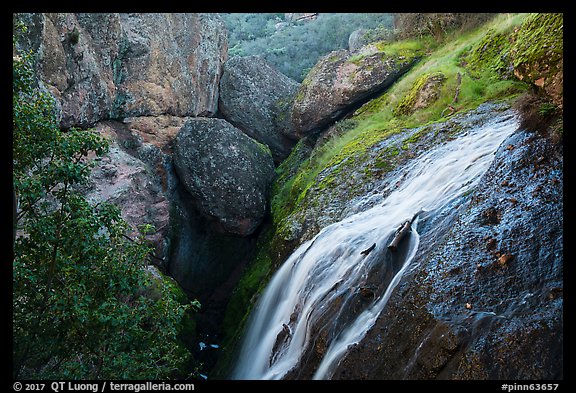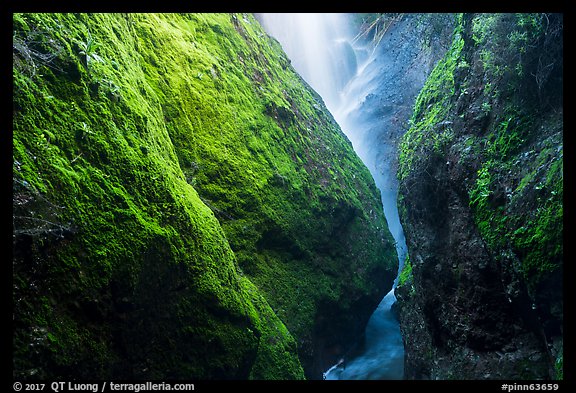Pinnacles Moses Spring Waterfall at Least
No Comments
For most of the year, Pinnacles National Park is quite a dry place. I revisited right after the high rains of this winter – which put to shame last year’s El Nino conditions, to observe the place transformed by the flow of the creeks and to photograph another elusive waterfall.
Pinnacles lies less than 50 miles from the Pacific Ocean, but the park is in the rain shadow of the Santa Lucia Mountains, resulting in a modest rainfall of 16 inches per year, mostly from January to March. The rest of the year sees frequent drought conditions, resulting in the hills being mostly covered by chaparral vegetation.

ISO 50, 24-70mm @26mm, 0.5s, f/16
To be sure that I would see the creeks flowing, I made a visit during the tail end of a period of rain. Although I had visited Pinnacles eight times since it became a national park in January 2013, this was the first time I saw the Chalone Creek flowing. To find a composition with a pleasant curve along the creek’s bank, I got my feet wet by crossing it. Using a polarizing filter, that I adjusted to maintain a balance between the silvery character of the creek and the color of its bed, let me slow the shutter speed just enough to smoothen the water. All the while, it was raining, which contributed to the atmosphere, but I just held my umbrella with my left hand, while controlling the camera on a tripod with my right hand.

ISO 200, 24-70mm @56mm, 15s, f/8
After Chalone Creek, I hiked Bear Gulch. Bear Creek was flowing nicely. It was the first time I saw the Moses Spring waterfall running that strongly, but it was getting quite dark. Since it was raining, I could not point the camera upwards to photograph its whole drop without getting the lens wet, and the water was not bright enough in comparison with the overcast sky. I made a distant photograph which failed to convey the height of the waterfall.

ISO 125, 24-70mm @65mm, 1/80s, f/8
My next visit was on a partly sunny Saturday, with the family. Because of timing and clouds at the wrong time, I had to content myself with a few hand-held photographs at Moses Spring, getting drenched in the process (to my wife’s disapproval) when an unexpected gust of wind shifted the waterfall towards me.

ISO 1000, 24-70mm @26mm, 1/60s, f/5.6
An easy-to-miss short spur from the main trail led to an unusually lush spot at the base of the waterfall. The hand-holding shutter speeds allowed me to capture the individual water drops and their impact in a small pool instead of longer streaks or mist that would have resulted from a slower shutter speed.

ISO 100, 16-35 @19mm, 15s, f/11
As the Bear Gulch caves were flooded and necessitated wading in knee-deep water, the photographic possibilities were intriguing, but nobody was in the mood for waiting. When I returned by myself on the next Monday, I was a bit disappointed that the waters had already receded to about ankle-deep, but it was still more than I’d seen in this location on previous years.


ISO 100, 24-70 @27mm, 0.3s, f/11
ISO 100, 24-70 @57mm, 1.6s, f/11
The flow level turned out to be excellent for photographing the waterfall that spills out from the reservoir into Upper Bear Gulch Cave. On Sunday, it had been more impressive, forming a solid sheet of water. However, I preferred the braids that appeared with Monday’s lower flow levels. Since it was a sunny day, I arrived there early to capture the scene in full shade before it would be partly illuminated by the morning sun.

ISO 50, 24-70 @53mm, 0.3s, f/22
My main goal, however, was to photograph the Moses Spring waterfall. I came better prepared than on Saturday, wearing full rain gear, and even bringing my spinning rain deflector, but the waterfall was again just a trickle. However, the best light conditions would nevertheless maximize the contrast enought to make the scant water sparkle. This meant that the water would have to be directly backlit by the sun against a background rock wall in the shade. Having studied the location on previous visits, I was able to estimate the proper time window precisely enough to make the photograph within half-an-hour of arriving on site, at 11:30am. I tried a range of shutter speeds, and liked the effect of stopping down to the maximum – I avoided using a filter since I needed to minimize lens flare.
The light conditions that I used to capture Moses Spring reminded me of Horsetail fall minus the sunset, but although I was lucky to photograph the world-renown waterfall on my first try, it took more persistence to at least photograph the modest Moses Spring.

